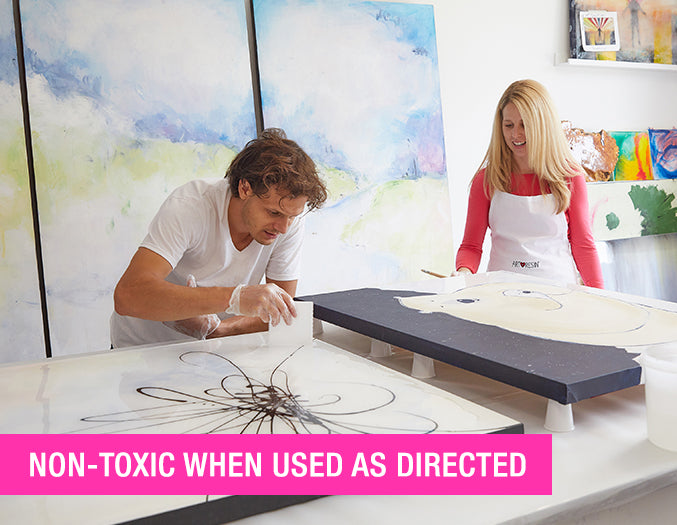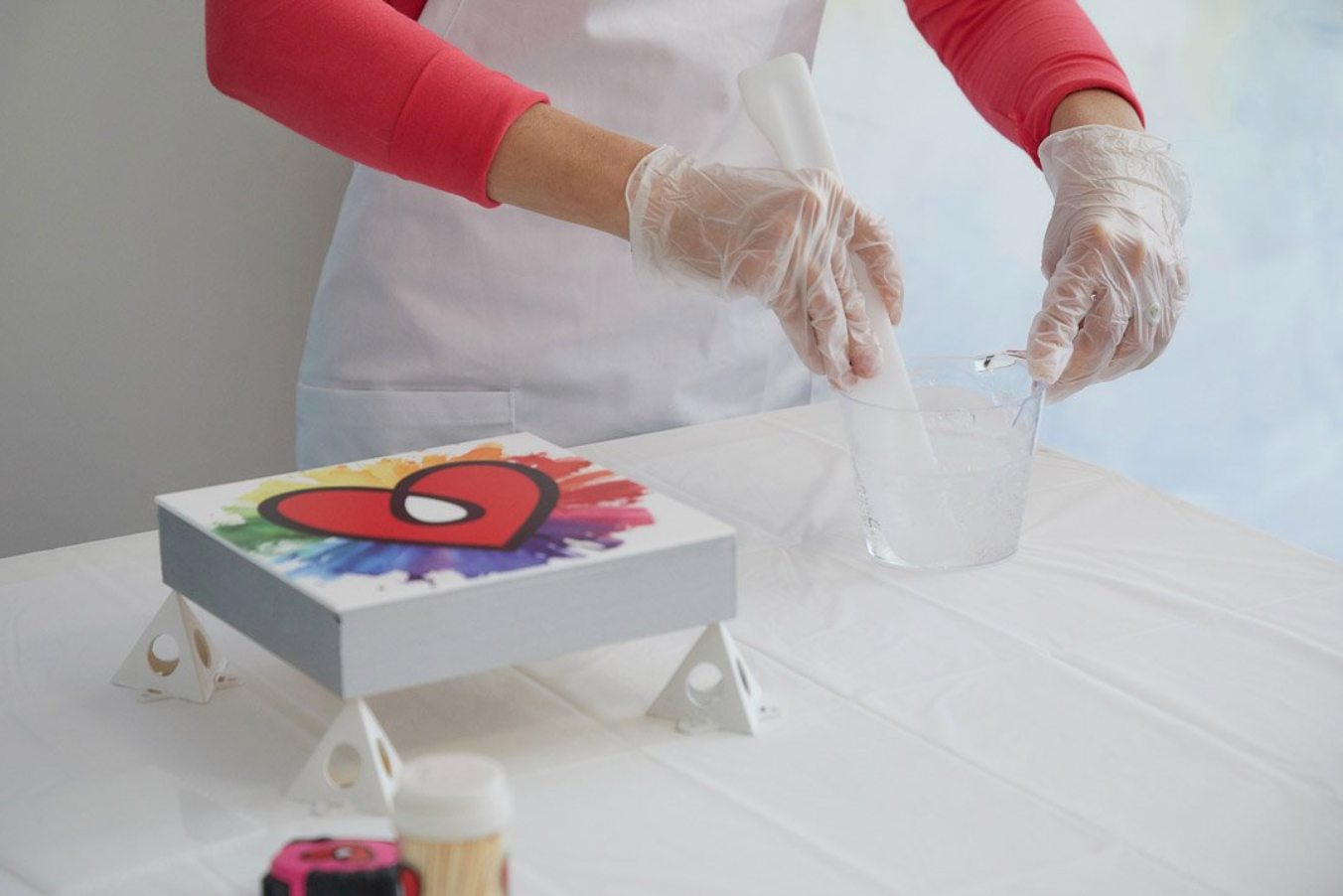Have you been curious about how to make resin art, but you're not sure where to begin?
You might be asking yourself:
What is resin?
Which resin is best for art and crafts?
What resin tools do I need?
What are some easy epoxy resin ideas for beginners?
If you're new to resin and feel uncertain, don't worry. Many people feel overwhelmed by the options available, but here at ArtResin, we've got you covered! Resin is surprisingly simple to use, as long as you follow a few basic guidelines . We've got step-by-step guidance, plus a list of Easy Resin Art Ideas, to help you get started with confidence.
Soon you'll be measuring, mixing and pouring resin like a pro.

Let's answer your questions.
What Is Resin?
When we're talking about resin for art or crafting, we're referring to epoxy resin. Epoxy resin is a clear liquid plastic made of up two parts: resin and hardener. When the resin and hardener are mixed together, a chemical reaction occurs that takes it from a liquid to a hard, shiny solid.








Which Resin Is Best For Arts and Crafts?
When you're starting out, you might be tempted to buy the cheapest epoxy resin you can find. The truth is, this is exactly the type of resin to stay away from! Cheap epoxy resins are not designed for art: they're often highly toxic, give off noxious fumes, and will turn yellow in no time, ruining your project and wasting your money. This really is a case where that old saying "You get what you pay for" is true. For your health and for your artwork, it's worth paying extra for a high quality epoxy resin.

This watercolor painting was ruined by cheap epoxy resin.
Why It's Important To Use ArtResin For Your Art:
Easy To Use:
There's no complicated weighing or confusing directions here. ArtResin is a 1:1 ratio, measured by volume. In other words, mix together precisely equal amounts of resin and hardener in a measuring cup.
Doesn't get easier than that!

Made For Art:
ArtResin has a beautiful, thick consistency which makes it easy to control and allows it to self-level as the resin hardens. This thick consistency is excellent for color separation in techniques like flow art, preventing the colors from mixing together and looking muddy.
It also has a long working time (about 40 minutes) so you can get your piece just right. It also has a short cure time: you'll be able to handle your pieces after about 24 hours.

Crystal Clear:
ArtResin was designed by artists who know exactly what artists want: a crystal clear resin that dries with a gorgeous glossy finish. ArtResin is also formulated with special ingredients to protect against yellowing to keep your art looking as good as the day you created it.

Safe:
Protecting your health is the single most important reason you need a resin made especially for art. ArtResin is non-toxic (when used as directed) so it's not bad for your health like other resins. It contains no nasty fumes, solvents or VOCs. It has a low odor and is safe to use at home when used in a well-ventilated area.
💡TIP: For the safety of your health and for artwork that will last, buy an epoxy resin that's safe for home use and designed specifically for art.

What Resin Tools Do I Need?
No matter what you're making, you'll need a few key resin tools when working with resin. As your confidence grows and you try more projects, you can start adding tools like colorants, silicone molds, 3D inclusions and more!
💡TIP: From the nice-to-haves to the need-to-haves, read more about resin tools in our blog Resin Art Tools For Beginners.

Here are the basic resin tools you'll need:
- ArtResin epoxy resin
- Mixing Containers
- Gloves, Stir Stick & Spreader
- Plastic Drop Sheet: to protect your work surface
- Level: to ensure your work is perfectly horizontal
- Torch: to get rid of bubbles
- Toothpicks: to fish out bits of dust
- Dust cover: to protect your work while it cures
Optional tools, depending on your project:
- plastic stands: to prop artwork up off of your work surface
- masking tape: for taping off the back of your piece to catch drips
- colorants: use colorants made for resin, like our ArtResin ResinTint
- small mixing cups & craft sticks: for mixing small amounts of tinted resin
- heat gun/hair dryer: to gently push your resin around for flow art
- silicone molds: for making coasters, jewellery and more
- alcohol ink: a must for making petri dish art
- inclusions: embellish your work with glitter, beads, shells, gold flake etc
How Do You Mix Resin?
We get it—the idea of using resin can seem intimidating at first, but the steps are actually very easy: measure, mix, pour, spread, torch and wait. No matter what you make, you'll be repeating those steps over and over again. We have a whole blog and video, How To Use Epoxy Resin, that explains each step in detail.

What Are Some Easy Resin Projects For A Beginner?
Feeling inspired to try a resin project? From coating a painting to creating coasters, flow art, trinket dishes and more, there is so much you can do with epoxy resin!
Here are ArtResin's Top 10 Easy Resin Project ideas to help you get started:
We hope you found this blog helped explain and demystify what resin is all about. Like anything, practice makes perfect but we hope you feel encouraged to try a resin project out for yourself. Before you know it, you'll be wondering why you didn't try it sooner.
And who knows? You might end up starting your own resin business! There's a huge opportunity in today's market for entrepreneurially minded resin artists. Read more about it in our blog What Resin Art Sells The Best & Where To Sell Resin Art.
Are you new in resin art? Read our guides below to help you get started:
- Resin Art Beginners's Guide
- Butane vs Propane Torch
- Top Resin Mistakes Made By Beginners
- Top 10 Easy Resin Projects For Beginners
- How to Resin On Canvas For Beginners
- Resin Materials For Beginners
- What Resin Art Sells The Best?
- Resin Art VS Acrylic Pour
- Casting Resin Vs Epoxy Resin
- How To Make Money As An Artist
Questions or comments? Please leave them below.
ArtResin: Made For Artists, By Artists
